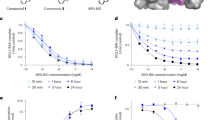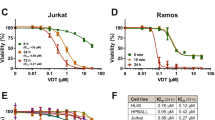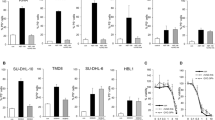Abstract
The 16-membered macrolide FD-891 exerts cytotoxicity toward several cancer cell lines. In this study, we showed that FD-891 induces apoptosis in various human cancer cell lines. Human leukemia Jurkat cells were highly sensitive to FD-891, exhibiting caspase activation and mitochondrial release of cytochrome c into the cytosol at early time points after exposure to FD-891. By contrast, Jurkat cells deficient in caspase-8 were resistant to FD-891-induced apoptosis and manifested little induction of cytochrome c release as well as caspase-9 processing. Consistent with these results, the overexpression of the Bcl-2 family member Bcl-xL or the caspase-8 modulator c-FLIPL markedly prevented FD-891-induced apoptosis. These results clearly demonstrate that FD-891 triggers caspase-8-dependent mitochondrial release of cytochrome c and subsequent apoptosis in Jurkat cells.
Similar content being viewed by others
Log in or create a free account to read this content
Gain free access to this article, as well as selected content from this journal and more on nature.com
or
References
Riedl, S. J. & Shi, Y. Molecular mechanisms of caspase regulation during apoptosis. Nat. Rev. Mol. Cell Biol. 5, 897–907 (2004).
Siegel, R. M. Caspases at the crossroads of immune-cell life and death. Nat. Rev. Immunol. 6, 308–317 (2006).
Krammer, P. H., Arnold, R. & Lavrik, I. N. Life and death in peripheral T cells. Nat. Rev. Immunol. 7, 532–542 (2007).
Luo, X., Budihardjo, I., Zou, H., Slaughter, C. & Wang, X. Bid, a Bcl2 interacting protein, mediates cytochrome c release from mitochondria in response to activation of cell surface death receptors. Cell 94, 481–490 (1998).
Li, H., Zhu, H., Xu, C. & Yuan, J. Cleavage of BID by caspase 8 mediates the mitochondrial damage in the Fas pathway of apoptosis. Cell 94, 491–501 (1998).
Chipuk, J. E., Bouchier-Hayes, L. & Green, D. R. Mitochondrial outer membrane permeabilization during apoptosis: the innocent bystander scenario. Cell Death Differ. 13, 1396–1402 (2006).
Garrido, C. et al. Mechanisms of cytochrome c release from mitochondria. Cell Death Differ. 13, 1423–1433 (2006).
Pop, C., Timmer, J., Sperandio, S. & Salvesen, G. S. The apoptosome activates caspase-9 by dimerization. Mol. Cell 22, 269–275 (2006).
Schafer, Z. T. & Kornbluth, S. The apoptosome: physiological, developmental, and pathological modes of regulation. Dev. Cell 10, 549–561 (2006).
Bao, Q. & Shi, Y. Apoptosome: a platform for the activation of initiator caspases. Cell Death Differ. 14, 56–65 (2007).
Taylor, R. C., Cullen, S. P. & Martin, S. J. Apoptosis: controlled demolition at the cellular level. Nat. Rev. Mol. Cell Biol. 9, 231–241 (2008).
Seki-Asano, M. et al. Isolation and characterization of new 18-membered macrolides FD-891 and FD-892. J. Antibiot. 47, 1226–1233 (1994).
Seki-Asano, M., Tsuchida, Y., Hanada, K. & Mizoue, K. Structures of new 18-membered macrolides FD-891 and FD-892. J. Antibiot. 47, 1234–1241 (1994).
Eguchi, T. et al. Stereostructure of a novel cytotoxic 18-membered macrolactone antibiotic FD-891. Org. Lett. 4, 3383–3386 (2002).
Eguchi, T., Yamamoto, K., Mizoue, K. & Kakinuma, K. Structure revision of FD-891, a 16-membered macrolide antibiotic. J. Antibiot. 57, 156–157 (2004).
Ogawa, H., Nakajima, S., Suzuki, H., Ojiri, K. & Suda, H. Antitumor agent BE-45653 manufacture with Streptomyces. Jpn. Kokai Tokkyo Koho 09087285 (1997).
Crimmins, M. T. & Caussanel, F. Enantioselective total synthesis of FD-891. J. Am. Chem. Soc. 128, 3128–3129 (2006).
García-Fortanet, J., Murga, J., Carda, M. & Marco, J. A. Stereoselective synthesis of the cytotoxic macrolide FD-891. Org. Lett. 8, 2695–2698 (2006).
García-Fortanet, J. et al. The total synthesis and biological properties of the cytotoxic macrolide FD-891 and its non-natural (Z)-C12 isomer. Chem. Eur. J. 13, 5060–5074 (2007).
Kataoka, T. et al. FD-891, a structural analogue of concanamycin A that does not affect vacuolar acidification or perforin activity, yet potently prevents cytotoxic T lymphocyte-mediated cytotoxicity through the blockage of conjugate formation. Immunology 100, 170–177 (2000).
Juo, P., Kuo, C. J., Yuan, J. & Blenis, J. Essential requirement for caspase-8/FLICE in the initiation of the Fas-induced apoptotic cascade. Curr. Biol. 8, 1001–1008 (1998).
Irmler, M. et al. Inhibition of death receptor signals by cellular FLIP. Nature 388, 190–195 (1997).
Kadohara, K. et al. Acetoxycycloheximide (E-73) rapidly induces apoptosis mediated by the release of cytochrome c via activation of c-Jun N-terminal kinase. Biochem. Pharmacol. 69, 551–560 (2005).
Nicholson, D. W. Caspase structure, proteolytic substances, and function during apoptotic cell death. Cell Death Differ. 6, 1028–1042 (1999).
Kataoka, T. et al. FLIP prevents apoptosis induced by death receptors but not by perforin/granzyme B, chemotherapeutic drugs, and gamma irradiation. J. Immunol. 161, 3936–3942 (1998).
Kataoka, T. et al. Identification of low molecular weight probes on perforin- and Fas-based killing mediated by cytotoxic T lymphocytes. Biosci. Biotech. Biochem. 60, 1726–1728 (1996).
Acknowledgements
This work was supported by a Grant-in-Aid for Scientific Research from the Ministry of Education, Culture, Sports, Science and Technology (MEXT), Japan.
Author information
Authors and Affiliations
Corresponding author
Rights and permissions
About this article
Cite this article
Inaba, S., Eguchi, T., Motegi, A. et al. The cytotoxic macrolide FD-891 induces caspase-8-dependent mitochondrial release of cytochrome c and subsequent apoptosis in human leukemia Jurkat cells. J Antibiot 62, 507–512 (2009). https://doi.org/10.1038/ja.2009.62
Received:
Revised:
Accepted:
Published:
Issue date:
DOI: https://doi.org/10.1038/ja.2009.62



